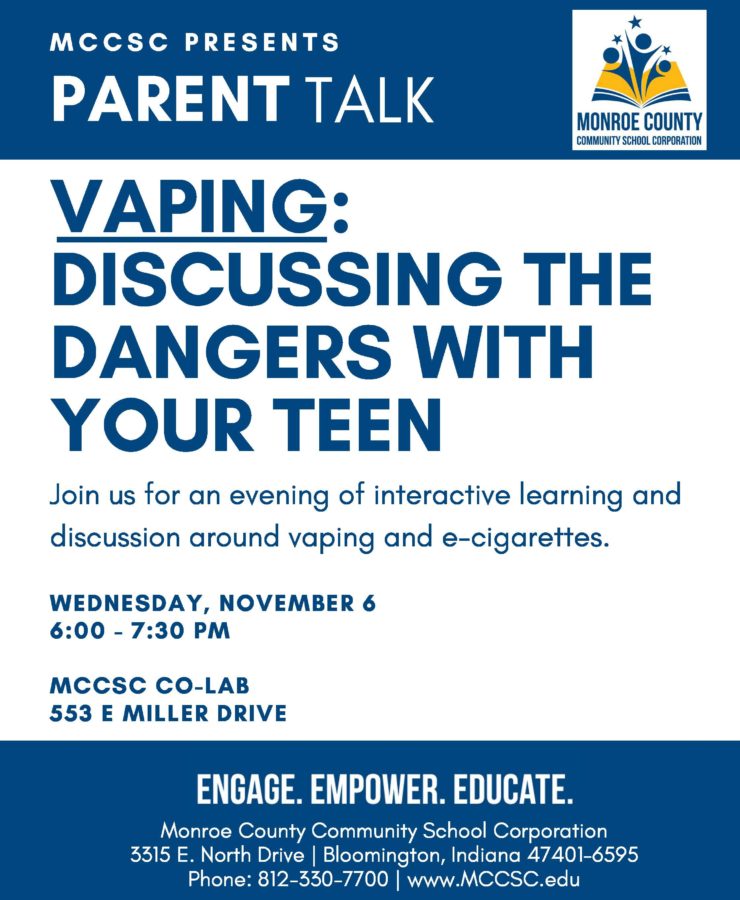
Carol Weiss-Kennedy
Director of Community Health
IU Health Bloomington
E-cigarettes have been described as a safe alternative to cigarettes. What do we know about the health impact of vaping/e-cigarettes compared to cigarettes?
The American Heart Association writes that although e-cigarette vapor may contain fewer toxic substances than cigarette smoke, it still exposes the user to toxins, metals, and contaminants.
There have been few studies about the long-term health impacts of vaping/e-cigarettes because they haven’t been on the market very long; however, recent studies by researchers at the University of Southern California (February 2019) found the same cancer-causing molecular changes in the oral tissues of people who vape as found in the oral tissues of cigarette smokers.
Why is e-cigarette use such an issue with teens and how do I talk to my child about vaping?
Until recently, many teens didn’t know what was in an e-cigarette. The marketing of these products was vague and focused on the look of the new devices rather than their effects on users. For example, Juul’s first marketing campaigns focused on the sleekness of the product utilized by young models with little to no mention of its high levels of nicotine or other chemicals. E-cigarettes have high levels of nicotine, which can have adverse effects on adolescent brain development. Many now know about the high levels of nicotine but are already addicted and are unable to quit.
In Monroe County, we have seen sixth-graders using e-cigarettes because they thought the tricks they could do with the smoke was cool. The US Surgeon General has a parent/guardian tip sheet to help get the conversation started with their child. Before the talk, know the facts, be patient and ready to listen, and set a positive example by being tobacco-free. When starting the conversation, find the right moment and ask for support from others such as a health care provider. https://e-cigarettes.surgeongeneral.gov/
What kinds of dangers or illness have been associated with e-cigarettes?
Patients across the United States are reporting trouble breathing, nausea, and fatigue. Some have been hospitalized and put on ventilators to help them breathe. As of October 8, 2019, 26 deaths have been confirmed. According to the CDC, no single product or substance (nicotine, THC, or other) has been linked to all lung injury cases.
What is the local health community doing to combat rising e-cigarette rates?

Youth and adult education about the dangers of smoking (including e-cigarettes) is available locally, including resources to quit. Resources include the following:
• MCCSC is hosting a parent discussion on the use of e-cigarettes from 6 to 7:30 p.m. on November 6, 2019. There will be a panel discussion with school administrators, a local pediatrician, and a local respiratory therapist.
• IU Health Bloomington Community Health has Beat Tobacco classes that aid adults in quitting. Trained tobacco educators lead free classes to offer guidance and support. Classes can be found at https://iuhealth.org/in-the-community/south-central-region/tobacco-prevention. Community members can call 812-353-5811 if they have further questions about the class.
• IU Health Bloomington Community Health has a Teens Beat Tobacco class that is offered every third Tuesday of each month from 4 to 5 p.m. at 333 E. Miller Drive. Students can learn more about the dangers of using tobacco and are provided information about the Indiana Tobacco Quitline and other texting services to help support their quit process.
• The Indiana Tobacco Quitline is a phone and web-based service to help youth 13-17 years of age and adults quit using tobacco products. Indiana residents can call 1-800-QUIT-NOW or visit quitnowindiana.com to start their smoke-free journey.
• The Truth Initiative has a youth texting line and a parent/guardian support line to help them quit vaping. Youth can text “DITCHJUUL” to 88709 and parents/guardians can text “QUIT” to 202-899-7550. Visit the Truth Initiative’s website to learn more: https://www.thetruth.com/articles/hot-topic/quit-vaping–
Are electronic cigarette (e-cigarette) rates lowering cigarette smoking rates?
According to the 2018 Indiana Youth Tobacco Survey, e-cigarette use is strongly associated with use of other tobacco products among youth, including cigarettes and other combustible tobacco products. Cigarette smoking among Indiana youth has significantly decreased since the year 2000, dropping from 31.6 percent to 8.7 percent in 2016. While those rates have declined, the rates of use for other tobacco products have not.
The Truth Initiative reported that national youth usage of e-cigarettes increased significantly between 2011 and 2017. In 2011, 1.5 percent of high school students reported using e-cigarettes, compared to 11.7 percent in 2017.
Electronic cigarettes (e-cigarettes) are the most commonly used tobacco product among Hoosier youth, with 10.5 percent of high schoolers and 2.8 perfect of middle schoolers reporting usage in 2016.
E-cigarettes usage primarily impacts youth and young adults. E-cigarette usage among adults 45 years and older is significantly lower than in younger age groups.
________________________________________________________
Carol has worked for over 37 years in the health and wellness field. Since 2007, she has been the director of community health for IU Health Bloomington. Other professional experiences include serving as program director of adult health and cardiopulmonary rehab for the Monroe County YMCA from 1981 to 2002. She went on to work with occupational health at Bloomington Hospital from 2002 until taking the position in community health in 2007.
Carol holds a BS in Community Health and an MS in Executive Development and Nonprofit Management, both from Ball State University.
She and her husband, Dan, have six children and are very active in the Bloomington community.

Recent Comments